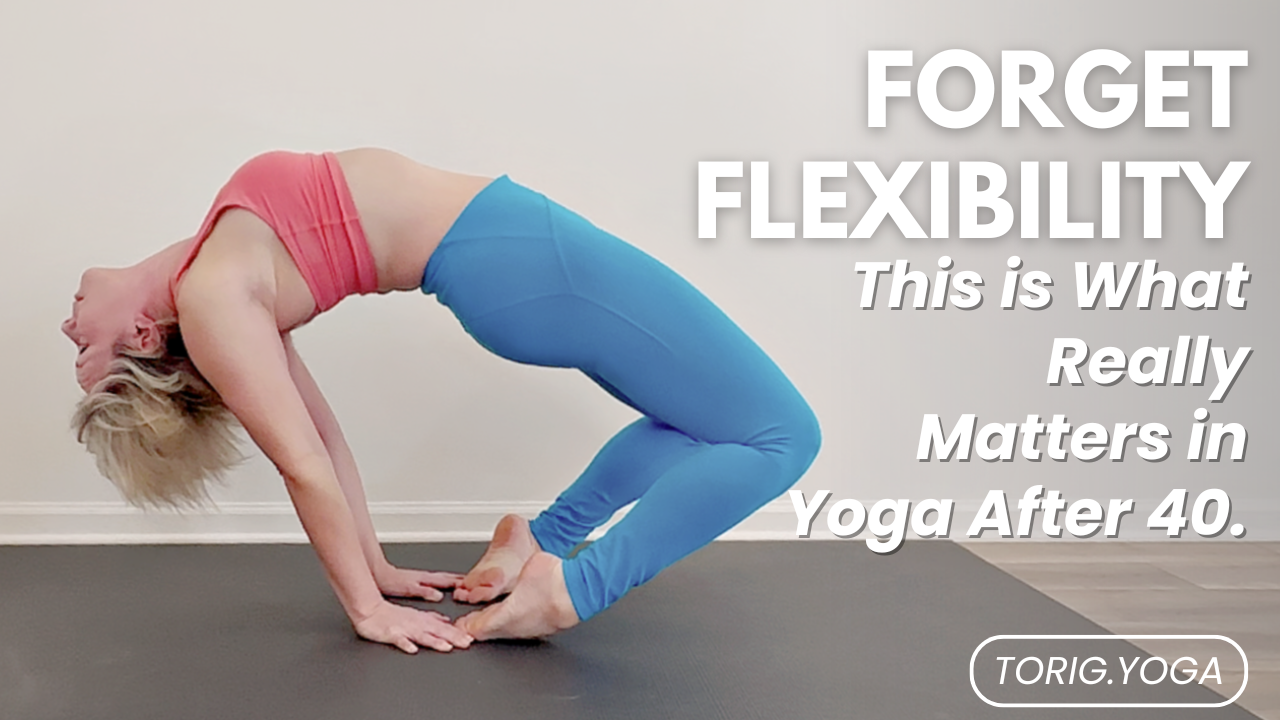
Forget Flexibility. This is What Really Matters in Yoga After 40
Feb 14, 2025If you’ve ever thought, “I wish I had started yoga sooner,” let me stop you right there.
The best time to practice yoga isn’t in your 20s. It’s right now—in your midlife years, when you’ve become a woman of a "certain age."
I get it. You see those 20-somethings in yoga class—their bodies are new, their flexibility seems effortless. It’s easy to assume yoga would have been simpler if you’d started earlier.
But here’s the truth: when you approach yoga with the wisdom you’ve gained over the years—and when you integrate strength and mobility principles into your practice—yoga actually works better as you age.
Why Yoga Gets Better with Age
Flexibility is great, but mobility and strength are what help you move with ease and avoid injury long-term.
And if you’re wondering, Wait, what’s the difference between flexibility and mobility?—let’s break it down.
Flexibility = Passive Range of Motion
- Definition: The ability of a muscle to stretch and lengthen passively.
- Example: If you lie on your back and someone pushes your leg into a hamstring stretch, that’s passive flexibility—your muscles aren’t actively doing the work.
- Common in: Deep static stretches like Splits, Forward Folds, or Pigeon Pose.
- The Problem? Being flexible doesn’t mean you can control that range of motion. Many yogis get injured because they have passive flexibility without the strength to support it.
Mobility = Active, Controlled Range of Motion
- Definition: The ability to move a joint through its full range with control and strength.
- Example: Lifting your leg into a standing split without using your hands. That requires both strength and mobility.
- Common in: Transitions, inversions, and dynamic poses like Handstands, Lotus, and Backbends.
Why Mobility Matters More for Yoga
You don’t just need to get into a pose—you need to control it. Mobility keeps your joints and muscles strong so you can hold poses longer and move safely.
A mobile yogi is a strong yogi.
And this is where your wisdom pays off.
With time, your ability to listen to your body improves. You become more intentional, more aware, and more in tune with what you truly need. That makes your yoga practice even more powerful.
But What If You’re Not Naturally Flexible?
I know you might look at my practice—or any seasoned yogi—and think, They must have been born with a special talent for this.
Let me set the record straight: yoga isn’t easier for some people. It’s simply that practice reveals where you’re weak and where you need to build strength.
I’ll be honest—I had a leg up when it came to flexibility. While most people lost theirs in their 20s, I was actively working to maintain mine for my career as a musical theater dancer.
But strength? That was a whole different story.
It wasn’t until I realized how much control I was missing that my yoga practice truly transformed.
The first time I lifted and held Crow Pose, I grinned like a kid on Christmas morning. That feeling of building something new within my body? Unmatched. (And by the way—I didn’t truly fly in Crow Pose until 2017… 12 years after I first stepped on a yoga mat. So trust me, you can do this too!)
Real Progress: A Student’s Story
One of my longtime students at the Tori G. Yoga Online Studio struggled with Malasana (Yogi Squat) for an entire year. Her hips were tight, and she had lost the natural mobility she was born with.
Fast forward to a year later—after incorporating strength and mobility work into her practice—and not only can she comfortably sink into Malasana, but she also moves easily in and out of boats and kayaks, something that used to frustrate her before she made these changes.
Yoga Is for This Moment—Not for the Young and Flexible
So if you’re in your 40s, 50s, 60s, or beyond, know this: yoga is for you.
It’s never too late to start. It’s never too late to return to your practice. And it’s never too late to transform it into something that supports you in every stage of life.
Big Hugs,
Tori G.
Ready to Take Your Practice Further?
Inside the Tori G. Yoga Online Studio, you’ll move beyond tips and into real transformation. Our classes don’t just stretch you—they strengthen your foundation, refine your technique, and support you in evolving your practice with purpose.
Expect:
- Weekly livestream classes.
- A huge on-demand classes library.
- A proven path to progress—no guesswork, no fluff.
- Individual coaching through 1-to-1 sessions and monthly Live Q&A Sessions.
Start your first month for $37 today and discover how stable, strong, and free your body can truly feel.



